Every year, four Korean artists (or artist groups) are selected as candidates for the Korea Artist Prize (올해의 작가상, KAP). They present several recent works at the National Museum of Modern and Contemporary Art in Seoul (국립현대미술관 서울관) and then one of the four positions is selected for the prize, worth 10 Mio. Korean Won (about $9000, in addition to the 40 Mio. KRW that all short listed artists receive).
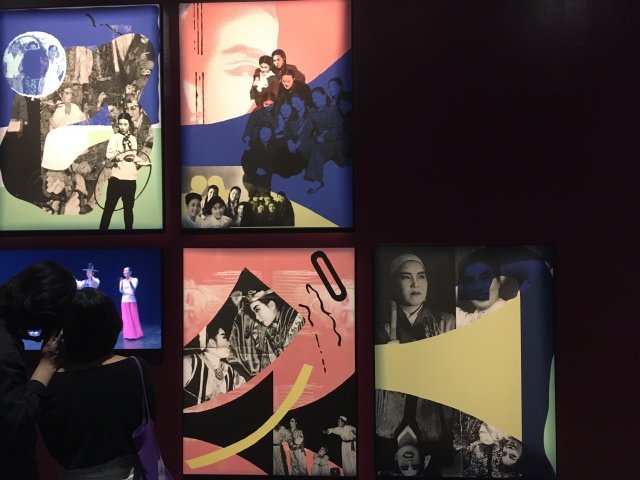
The winner of this year’s KAP was announced rather early, already in September (the earliest article I found is from Hankyoreh, there is also an English one in Korea Herald): After the collective Mix Rice (믹스라이스, 2016) and Amsterdam-based video artist Song Sanghee Song (송상희, 2017), this year’s award goes to siren eun young jung (정은영). siren eun young jung (the preferred romanized spelling of the artist) is known for her work on the music theatre genre yeoseong gukgeuk (여성국극), an all-female variation of the better known changgeuk (창극) that had its heydays in South Korea of the 1950s and 60s.
Often derided as a popular derivative of changgeuk or pansori – the traditional singing/storytelling art that both “modern” genres changgeuk and yeoseong gukgeuk are rooted in –, yeoseong gukgeuk has been in the shadows of its more “respectable” others. In fact, however, many of the best pansori singers, some of them honored with the rank of “living cultural treasure” (인간문화재), also performed in yeoseong gukgeuk-ensembles. In English, there is an interesting chapter in Andrew Killick’s book on changgeuk (In Search of Korean Traditional Opera, 2010) that deconstructs some of the common, mostly negative assumptions on this genre as fed by male pansori performers for their own reasons. In the art world, siren eun young jung, in turn, rediscovered yeoseong gukgeuk from the dustbin of history and, in a way, did the research that scholars mostly had failed to do.
I saw the KAP exhibition later that month, on the the last Wednesday of September, when public museums offer free entrance. I had missed an earlier solo show by siren eun young jung at Art Space Pool (“Trans-Theatre”, 전환극장, 아트 스페이스 풀, 2015.08.20–09.20), so now was a good occasion to see art work that also touched my research interests in theatre.
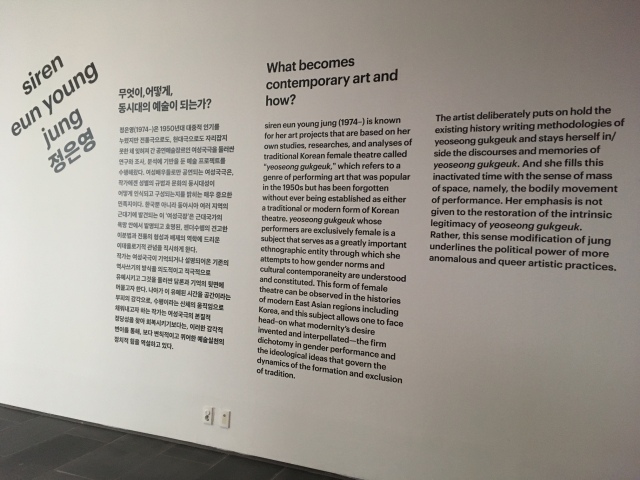
Generally speaking, yeoseong gukgeuk as an artistic practice is a thing of the past. Although apparently some ensembles exist, performances are rare. I once saw a production of Chunhyang-jeon (춘향전, “The Story of Chunhyang”, after the famous pansori piece) at the National Gugak Center back in 2010, on the occasion of the Dano Day festivities.
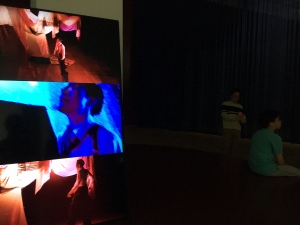 The performance of the well-known story, the singers wearing traditional costumes and the stage decorated in the typical slightly old-fashioned style of classical changgeuk was wonderful, yet – in a way surprisingly – similar to other mixed-cast productions I had seen. Definitely more neo-traditional (or “traditionesque”, in Killick’s terms) than experimental, my experience watching yeoseong gukgeuk fit the formula of family-entertainment I was used to from changgeuk.
The performance of the well-known story, the singers wearing traditional costumes and the stage decorated in the typical slightly old-fashioned style of classical changgeuk was wonderful, yet – in a way surprisingly – similar to other mixed-cast productions I had seen. Definitely more neo-traditional (or “traditionesque”, in Killick’s terms) than experimental, my experience watching yeoseong gukgeuk fit the formula of family-entertainment I was used to from changgeuk.
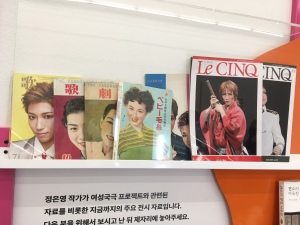 siren eun young jung’s exhibition, while largely documentary, thus offers a re-reading of this genre, for instance when she includes more recent cross-dress performances. She also presents staged videos with former yeoseong gukgeuk stars, as well as collages of promotional material (see image above), and in her writings (and on-site research material, see left) draws connections to the Japanese all-female music theatre troupe Takarazuka Revue. In a video interview on the occasion of the KAP exhibition, she explains her motivations herself (via Vimeo, also a written interview).
siren eun young jung’s exhibition, while largely documentary, thus offers a re-reading of this genre, for instance when she includes more recent cross-dress performances. She also presents staged videos with former yeoseong gukgeuk stars, as well as collages of promotional material (see image above), and in her writings (and on-site research material, see left) draws connections to the Japanese all-female music theatre troupe Takarazuka Revue. In a video interview on the occasion of the KAP exhibition, she explains her motivations herself (via Vimeo, also a written interview).
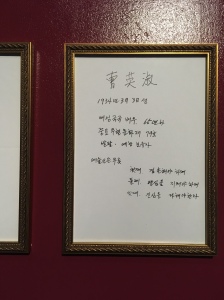 There are also many interesting details, for example in the collected testimonies of yeoseong gukgeuk singers, framed and put on the wall. One of them, Cho Young-sook (조영숙 槽英淑), who performed comical male roles (in Japanese sammai, a heroic male role being nimai), identifies herself as “Holder of Talent in Baltal, Important Intangible Asset No. 79” (중요무형문화재 79호 발탈 예능보유자), in other words the highest-ranking performer (aka “Living Cultural Treasure”, 인간문화재) of a particular kind of puppetry, where puppet heads are attached to the performer’s feet (baltal lit. means “footmask”). One of her recent performances also includes a scene of madang-geuk, a part from Simcheong-ga with herself in the role of “Blindman Sim”, which I suspect to be derived from an earlier yeoseong gukgeuk production. Unfortunately, I couldn’t see the performance for myself…
There are also many interesting details, for example in the collected testimonies of yeoseong gukgeuk singers, framed and put on the wall. One of them, Cho Young-sook (조영숙 槽英淑), who performed comical male roles (in Japanese sammai, a heroic male role being nimai), identifies herself as “Holder of Talent in Baltal, Important Intangible Asset No. 79” (중요무형문화재 79호 발탈 예능보유자), in other words the highest-ranking performer (aka “Living Cultural Treasure”, 인간문화재) of a particular kind of puppetry, where puppet heads are attached to the performer’s feet (baltal lit. means “footmask”). One of her recent performances also includes a scene of madang-geuk, a part from Simcheong-ga with herself in the role of “Blindman Sim”, which I suspect to be derived from an earlier yeoseong gukgeuk production. Unfortunately, I couldn’t see the performance for myself…
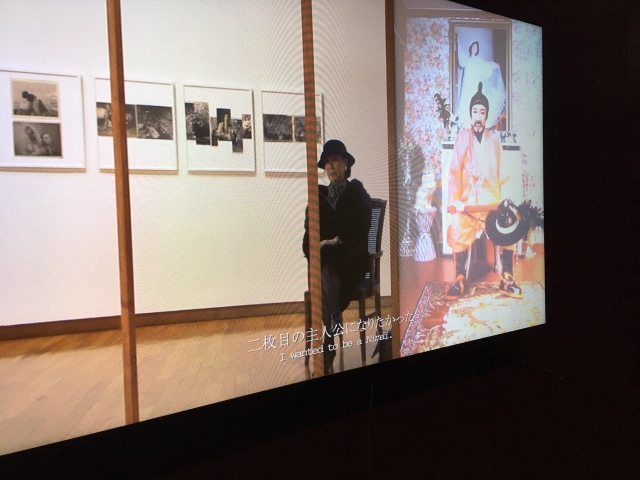 Back to the art world: siren eun young jung has also been announced to be part of the South Korean line-up for the upcoming Venice Biennale 2019. I expect for yeoseong gukgeuk to gain a wider audience there, something that is definitely do be desired, as the genre promises to offer many fascinating insights into the workings of the traditional art world. jung’s archive-based art is certainly interesting from a scholarly perspective, too, and shows the need for more in-depth research on the genre, its historical development, and contemporary potential.
Back to the art world: siren eun young jung has also been announced to be part of the South Korean line-up for the upcoming Venice Biennale 2019. I expect for yeoseong gukgeuk to gain a wider audience there, something that is definitely do be desired, as the genre promises to offer many fascinating insights into the workings of the traditional art world. jung’s archive-based art is certainly interesting from a scholarly perspective, too, and shows the need for more in-depth research on the genre, its historical development, and contemporary potential.
— 29 Sept. 2018 (水)

Pingback: Pansori, Relational Art, and the Gwangju Biennale 2024 | Seoul Stages